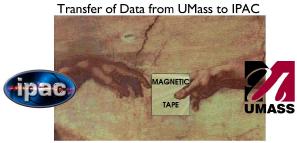2MASS: The All Sky Infrared Survey
2MASS was developed to close the
gap between current technical capabilities and our knowledge of the
infrared sky. 2MASS is designed to observe at
the shortest of infrared wavelengths, the region of the electromagnetic
spectrum astronomers call the near infrared.
 An observing "schedule file" was sent down from UMass to the telescope operator
at each
of the two facilities for each night. Computers used these files to
automatically control the telescopes throughout the night. The operator at
each facility monitored the telescope operations and the acquiring of data.
Each morning the digital data were written to magnetic tape storage, and the
tapes were sent to IPAC. Each night's data were put through an automated
"pipeline" of computer programs, which convert
the raw images made by the
telescopes into final processed images and
catalogs containing star and galaxy
brightnesses and positions. These data were assessed
for quality, through some human intervention. If these data passed muster,
they were included as part of the enormous 2MASS
database, from which
a digital image atlas of the sky and
catalogs of point sources and extended sources,
freely available to astronomers and the public at large, were assembled and
distributed.
An observing "schedule file" was sent down from UMass to the telescope operator
at each
of the two facilities for each night. Computers used these files to
automatically control the telescopes throughout the night. The operator at
each facility monitored the telescope operations and the acquiring of data.
Each morning the digital data were written to magnetic tape storage, and the
tapes were sent to IPAC. Each night's data were put through an automated
"pipeline" of computer programs, which convert
the raw images made by the
telescopes into final processed images and
catalogs containing star and galaxy
brightnesses and positions. These data were assessed
for quality, through some human intervention. If these data passed muster,
they were included as part of the enormous 2MASS
database, from which
a digital image atlas of the sky and
catalogs of point sources and extended sources,
freely available to astronomers and the public at large, were assembled and
distributed.
Back to Surveying the Sky in the Infrared
On to The Impact of 2MASS
Return to the 2MASS Home Page

